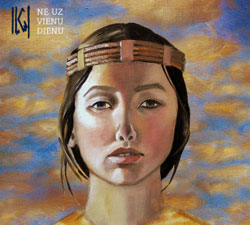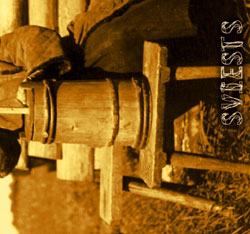
Ne uz vienu dienu, the newest compact disc by the Latvian modern folklore group Iļģi, has made it to No. 2 on World Music Charts Europe, where it is in good company with top groups from around the world. This is the highest international placing for a Latvian world music group and a powerful statement about the recording’s and the group’s quality.
Ne uz vienu dienu (Not for Just One Day) is a CD of wedding songs. But this is not an educational collection in the obvious sense; the songs do not form a complete wedding ceremony set. The best-known part of the ceremony—mičošana—is sung about in only one song, “Līgodama upe nesa.” Instead, Iļģi deals to a much greater extent with the more vague issue of beginning a new stage in one’s life.
“Tautiets jūdza bāliņš jūdza, Visi meži guni dega” and “Viena saule viena zeme” are beautiful texts about a bride wishing that her new home will be kind and that her married life will be gentle. These could be tear-jerkers, but Iļģi does not dwell on melancholy. Rather, as the liner notes state, even though a wedding is a serious event, it is nevertheless a happy one. The heavy “Dej eglīte, lec eglīte” bids a dignified farewell to the bride’s old life and proudly greets her new life. In “Kodaļa sprēslīca” the new bride’s lonely spinning wheel is encouraged to follow her to her new husband’s house, but the new couple has already exchanged rings, and now no one can undo the vows anymore. In “Skaista mana līgaviņa” the new bridegroom sings about his bride’s beauty and gently offers his shoulder for her to sleep.
Iļģi keeps on expanding its influences, this time by including African musician Samite on kalimba and German musician Mark Feder on banjo. Both instruments fit surprisingly well with Latvian folk melodies and the result is very pleasant world music. Of course, Iļģi plays all of its regular folk instruments as well: kokle, bagpipe, wooden flutes, ģīga, etc. The addition of Rūta Muktupāvela and three singers from the group Saucējas is also very fitting, because weddings are not usually the place for solo singing—everyone is expected to join in.
Despite a few calmer songs, the overall feel of Ne uz vienu dienu is almost exceedingly upbeat. All in all, though, this is another very polished CD typical of Iļģi, “restrained and yet refreshing,” according to World Music Charts Europe.
Details
Ne uz vienu dienu
Iļģi
Upe Records, 2006
UPECD 069




